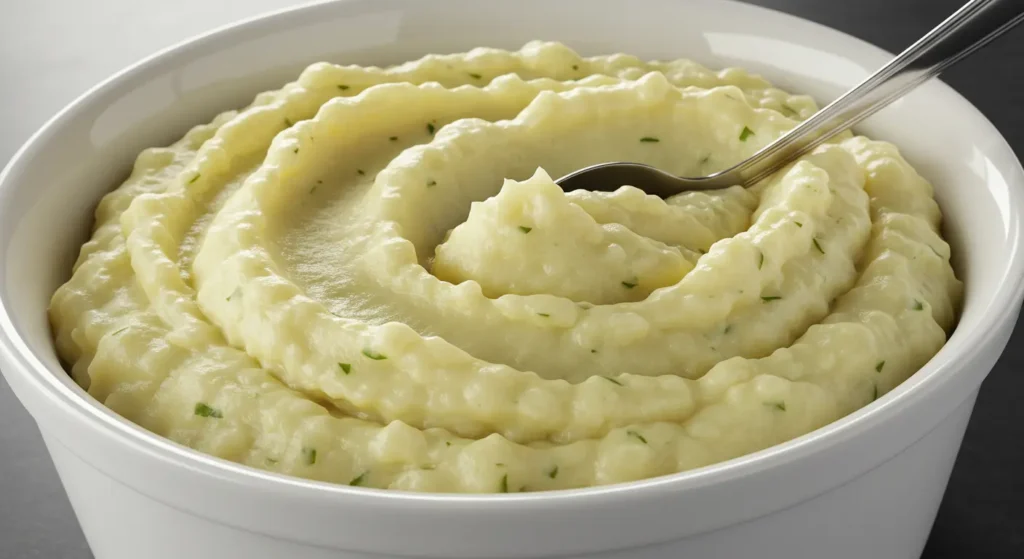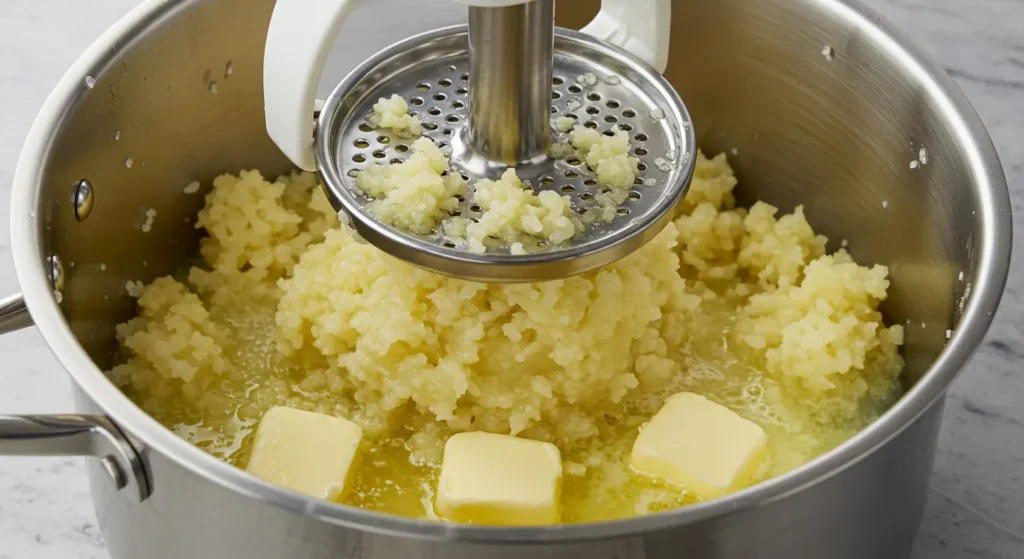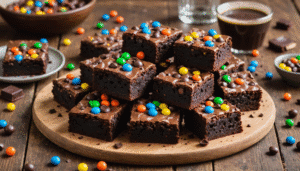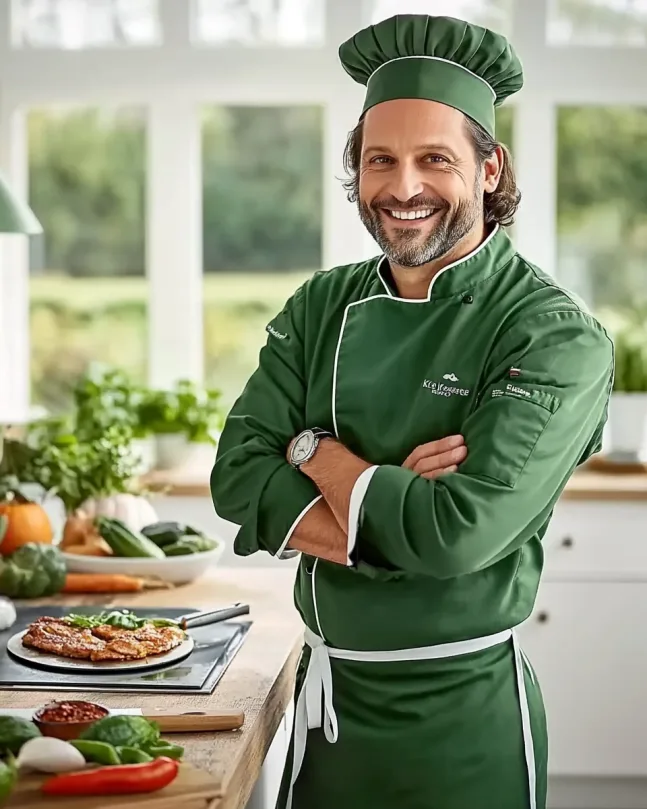Gordon Ramsay Mashed Potatoes – Why This Recipe?
As Chef Greeny, I’ve experimented with countless mashed potato recipes over the years, but none have impressed me quite like Gordon Ramsay’s approach. I still remember the first time I attempted his technique – it was for a holiday dinner with my in-laws, and I was determined to elevate this humble side dish. The moment everyone took their first bite of these incredible potatoes, the table fell silent, followed by exclamations of delight. That’s the power of Ramsay’s recipe!
What makes Gordon Ramsay mashed potatoes special isn’t just the creamy texture or rich flavor – it’s the attention to detail and technique that transforms ordinary potatoes into something extraordinary. Ramsay approaches this classic side with the same precision and care he brings to fine dining cuisine.
In my version of this celebrated recipe, I’ve incorporated a hint of roasted garlic that adds depth without overpowering the natural potato flavor. I’ve also perfected the temperature control technique that Ramsay is famous for, ensuring your potatoes achieve that cloud-like consistency.
By the end of this post, you’ll learn not just how to make Gordon Ramsay’s famous mashed potatoes, but also understand the science behind what makes them so exceptional, variations to suit dietary needs, and professional tricks to elevate this comfort food classic to restaurant quality.
Gordon Ramsay Mashed Potatoes – Ingredients and Preparation
Ingredients List
For perfect Ramsay-style mashed potatoes, gather these ingredients (serves 4-6):
- 2 pounds (900g) Yukon Gold potatoes (Ramsay’s preferred variety)
- 1/2 cup (115g) unsalted butter, cubed and chilled
- 1/2 cup (120ml) heavy cream, warmed
- 1/4 cup (60ml) whole milk, warmed
- 4 cloves garlic, peeled (optional)
- 2-3 sprigs fresh rosemary (optional)
- Sea salt, to taste
- Freshly ground white pepper, to taste
- 1 tablespoon olive oil (for roasting garlic, if using)
Substitution options:
- Dietary alternatives:
- Vegan: Substitute butter with plant-based butter and use unsweetened almond or oat milk instead of dairy
- Lactose-free: Use lactose-free butter, cream, and milk
- Lower-fat: Replace heavy cream with half-and-half or more milk
- Potato varieties: If Yukon Gold isn’t available for your Gordon Ramsay mashed potatoes, use Russet potatoes (more fluffy) or red potatoes (more buttery)
Step-by-Step Instructions
- Prepare the potatoes – Peel the potatoes and cut them into evenly-sized chunks (about 2 inches). Consistent sizing ensures even cooking.
- Chef’s tip: Don’t cut the potatoes too small or they’ll absorb too much water during boiling.
- Rinse the potatoes – Place cut potatoes in a colander and rinse under cold water until the water runs clear. This removes excess starch for fluffier results.
- Chef’s tip: This step is crucial for Ramsay’s technique – removing excess starch prevents gumminess.
- Cook the potatoes – Place the potatoes in a large pot and cover with cold water (starting with cold water helps cook the potatoes evenly). Add 1 tablespoon of salt. Bring to a boil over high heat, then reduce to a simmer.
- Chef’s tip: Never add potatoes to already boiling water as this cooks the outside faster than the inside.
- Test for doneness – Simmer for about 15-20 minutes until the potatoes are tender when pierced with a knife. They should offer no resistance but shouldn’t be falling apart.
- Chef’s tip: Overcooking will make waterlogged potatoes, while undercooking results in lumpy Gordon Ramsay mashed potatoes.
- Drain thoroughly – Once cooked, drain the potatoes in a colander and return them to the hot pot (off the heat). Allow them to steam dry for 2-3 minutes.
- Chef’s tip: This is a signature move in this recipe – letting the moisture evaporate ensures your mash isn’t watery.
- Optional garlic infusion – While the potatoes are cooking, roast whole garlic cloves in olive oil with rosemary sprigs until golden and fragrant. Remove the rosemary before adding to potatoes.
- Chef’s tip: This adds subtle flavor without the harshness of raw garlic.
- Mash the potatoes – Use a potato ricer or food mill for the smoothest texture (Ramsay’s preferred method). If using a masher, be gentle to avoid overworking the potatoes.
- Chef’s tip: Never use a food processor or blender, which will break down the starch cells and create a gluey texture.
- Add the butter first – Return the pot to low heat and fold in the cold cubed butter while the potatoes are still hot.
- Chef’s tip: Adding butter before liquid allows the fat to coat the starch molecules, resulting in silkier texture.
- Incorporate warm dairy – Slowly add the warmed cream and milk, stirring gently with a wooden spoon or spatula.
- Chef’s tip: Warming the dairy prevents the potatoes from cooling too quickly and helps them absorb the liquid better.
- Season to perfection – Add salt and white pepper to taste. White pepper is preferred as it doesn’t leave specks in your creamy potatoes.
- Chef’s tip: Season gradually and taste as you go – you can always add more, but you can’t take it away.
- Final whip – For Gordon Ramsay’s signature smooth finish, use a whisk for a final gentle whipping, incorporating air for a lighter texture.
- Chef’s tip: Don’t overwhip or you’ll activate the potato starch and create a gummy consistency.
Notes and Tips
- Storage: Refrigerate leftover mashed potatoes in an airtight container for up to 3 days.
- Reheating: Add a splash of cream or milk when reheating to restore creaminess. Warm gently on the stovetop or microwave on medium power, stirring occasionally.
- Make-ahead instructions: You can prepare these Gordon Ramsay mashed potatoes up to 2 hours before serving. Keep them warm in a heatproof bowl set over a pot of simmering water, covered with plastic wrap or a lid.
- Serving suggestions: Serve alongside roast chicken, beef Wellington, or as a base for Ramsay’s shepherd’s pie. A sprinkle of fresh chives or a drizzle of quality olive oil makes for an elegant presentation.
Gordon Ramsay Mashed Potatoes – Nutritional Information
Nutrition Facts (Per Serving, based on 6 servings)
| Nutrient | Amount |
|---|---|
| Calories | 285 |
| Carbohydrates | 30g |
| Protein | 4g |
| Total Fat | 18g |
| Saturated Fat | 11g |
| Unsaturated Fat | 6g |
| Trans Fat | 0g |
| Fiber | 2g |
| Sugar | 2g |
| Cholesterol | 52mg |
| Sodium | 340mg |
Note: Nutritional values are approximate and may vary based on specific ingredients and portion sizes.
Gordon Ramsay Mashed Potatoes – History and Cultural Significance
Mashed potatoes have been a staple comfort food across many cultures, dating back to 1771 when they first appeared in a cookbook by French culinary master Antoine Parmentier. However, Gordon Ramsay has revolutionized this classic dish by applying precise French culinary techniques to achieve the perfect texture and flavor balance.
Ramsay, a British chef trained in French cuisine, brings together the best of both culinary worlds. In British tradition, mashed potatoes (often called “mash”) are a cornerstone of comfort food, accompanying dishes like bangers and mash or Sunday roast. The French influence comes through in Ramsay’s technique – particularly the careful temperature control and incorporation of butter.
What distinguishes Gordon Ramsay’s approach is his insistence on treating this humble side dish with star-quality attention. He applies the same level of care to mashed potatoes that he would to a fine dining entrée, elevating them from simple comfort food to a culinary achievement.
Across different regions, you’ll find fascinating variations of mashed potatoes:
- In Ireland, colcannon incorporates cabbage or kale into mashed potatoes
- Swedish potato puree often includes nutmeg
- American versions frequently include sour cream for tanginess
- Italian variations might include Parmesan cheese or truffle oil
Ramsay’s version stands out for its purity of flavor and exceptional technique, allowing the natural potato flavor to shine while achieving that perfect, luxurious texture.
Gordon Ramsay Mashed Potatoes – Creative Variations
Truffle and Parmesan Mashed Potatoes
For a luxurious twist on Ramsay’s classic technique:
- Follow the base Gordon Ramsay mashed potatoes recipe
- Add 2 tablespoons of white truffle oil after incorporating the butter
- Fold in 1/3 cup freshly grated Parmesan cheese
- Finish with a sprinkle of chopped chives and fresh black pepper
Chef’s note: The earthy truffle flavor pairs beautifully with the creamy potatoes, while the Parmesan adds a salty umami dimension that elevates the entire dish.
Vegan Gordon Ramsay-Style Mashed Potatoes
A plant-based version that doesn’t sacrifice creaminess:
- Use the same potato preparation technique
- Substitute butter with 1/2 cup high-quality vegan butter
- Replace dairy with 1/2 cup warmed almond milk and 1/4 cup olive oil
- Add 1 tablespoon nutritional yeast for a subtle cheesy flavor
- Season with roasted garlic, salt, and white pepper
Chef’s note: The key to vegan mashed potatoes is to keep the same technique but adjust the fat-to-liquid ratio. The combination of vegan butter and olive oil creates the silky texture that makes Ramsay’s recipe famous.
Low-Carb Cauliflower “Mashed Potatoes”
For those watching their carbohydrate intake:
- Replace potatoes with 2 medium cauliflower heads, cut into florets
- Steam cauliflower until very tender, about 10-12 minutes
- Drain thoroughly and allow to steam dry (crucial step from Gordon Ramsay’s technique!)
- Process in a food processor until smooth (unlike potatoes, cauliflower won’t become gluey)
- Follow the remaining steps from the original recipe
- Add 1/4 cup cream cheese for extra body and stability
Chef’s note: While not traditional, this variation applies Ramsay’s techniques to create the closest low-carb alternative. The thorough draining and proper fat incorporation are key to achieving a texture that rivals the potato version.
Gordon Ramsay Mashed Potatoes – Frequently Asked Questions
Can I make Gordon Ramsay mashed potatoes ahead of time?
Yes, you can prepare this recipe up to 24 hours in advance. Store them in an airtight container in the refrigerator, then reheat gently on the stovetop over low heat. Add a splash of warm cream or milk while stirring to restore the creamy consistency. For best results, prepare them no more than 2 hours before serving and keep warm in a heatproof bowl set over a pot of barely simmering water.
What’s the best potato variety for Gordon Ramsay mashed potatoes?
Ramsay specifically recommends Yukon Gold potatoes for his recipe due to their buttery flavor and ideal starch content. These potatoes create the perfect balance between fluffy and creamy. If Yukon Golds aren’t available, you can use Russet potatoes (which will create a fluffier result) or Maris Piper potatoes (popular in the UK). Avoid waxy potato varieties like Red Bliss or new potatoes, as they contain less starch and create a gluey texture when mashed.
Why are my mashed potatoes gluey instead of fluffy?
Gluey mashed potatoes are typically the result of overworking the potatoes or improper preparation. To avoid this common mistake with Gordon Ramsay’s recipe:
- Never use a food processor or blender
- Ensure potatoes are thoroughly dried after boiling
- Add butter before adding any liquid
- Use a ricer or food mill instead of vigorous mashing
- Stir gently rather than beating vigorously
How can I make these mashed potatoes healthier?
To create a lighter version of Gordon Ramsay mashed potatoes while maintaining the technique:
- Substitute half the butter with extra virgin olive oil
- Use half-and-half instead of heavy cream
- Incorporate Greek yogurt (2 tablespoons) for creaminess with less fat
- Keep the skins on for added fiber and nutrients (just scrub potatoes thoroughly)
- Use chicken or vegetable broth to replace some of the dairy
What does Gordon Ramsay serve with his mashed potatoes?
Ramsay often pairs his mashed potatoes with:
- Beef Wellington (his signature dish)
- Pan-seared scallops
- Rack of lamb
- Slow-roasted beef short ribs
- Filet mignon with red wine reduction
The creamy texture and buttery flavor complement rich, savory main courses particularly well.
Gordon Ramsay Mashed Potatoes – Final Thoughts
Mastering Gordon Ramsay’s mashed potatoes is about understanding that greatness comes from respecting simple ingredients and applying precise technique. What sets this recipe apart isn’t exotic ingredients or complicated steps – it’s the attention to detail in each stage of the process.
From selecting the right potato variety to the careful order of adding ingredients, Ramsay’s method teaches us that even the most humble dishes deserve culinary respect. The result is mashed potatoes that aren’t just a side dish but often become the highlight of the meal.
I encourage you to approach this Gordon Ramsay mashed potatoes recipe with patience and attention to detail. Take your time with each step, especially the drying of the potatoes and the gentle incorporation of ingredients. The difference between good mashed potatoes and exceptional ones often comes down to these seemingly small details.
Whether you’re preparing them for a holiday feast, Sunday dinner, or to accompany a special meal, these Gordon Ramsay mashed potatoes will undoubtedly impress. I’d love to hear about your experience with this recipe – did you try any variations? What did you serve them with? Share your culinary journey in the comments below!
As you continue to explore classic dishes with professional techniques, remember that cooking is both science and art – understanding why certain methods work helps you develop your own culinary intuition and creativity.







